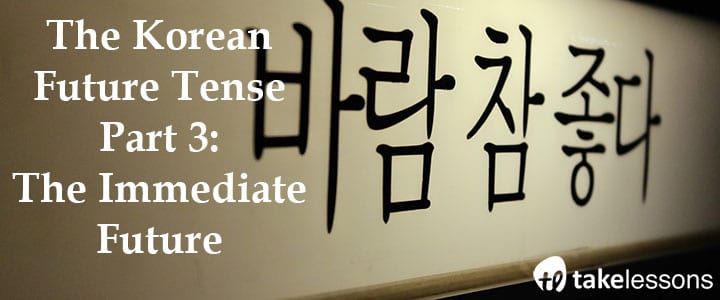In our continued series on describing the future in Korean, language teacher Bryce J. explains how to use the immediate future tense in Korean…
When you learn Korean, you will be introduced to four different ways to describe the future. Today we will look at one part of Korean grammar called the immediate/promised future.
Before you start learning the immediate future, however, make sure you review the probable and definite future:
- The Korean Future Tense Part 1: Describing the Probable Future
- The Korean Future Tense Part 2: Definite Future
The immediate/promised future tense is only used in Korean grammar with verbs and with the adjective 있다 (have). It is always used in first person (I, we), and the action in the sentence generally provides a benefit to the person listening or reading the sentence.
The immediate future tense implies a promise made by the speaker.
Here is a great look at the different forms of the future tense in Korean.
Grammatical Rule – Verb Stem + (으)ㄹ게요.
In English, you convey the immediate/promised future by intonation rather than using a specific word or phrase. Think of the way a person willingly volunteers to do something as compared to the intonation in a resigned acceptance of one’s fate.
Listen to the audio clip below for an example of this idea:
Karen’s reply to her boss when she says, “shoot. I will. Sorry.” would best be spoken in Korean with “… 하겠습니다…” or the future-presumptive [Predicate Stem + 겠다].
When Jim replies by saying, “Oh yeah, definitely,” the intonation, as much as his word choice, conveys his promise to do something. In a Korean subtitle, his reply would look like this: “어..네, 제가 할게요,” which uses the immediate future tense.
Here are some additional examples of how to use the immediate future tense:
점심은 내가 낼게요. ( I’ll pay for lunch.)
(OR Let me pay for lunch. OR Why don’t I pay for lunch.)
선생님: 누가 읽겠어요? (Who will read?) A teacher would ask her students this.
A student would then respond by saying: 학생: 제가 읽을게요. (volunteering) I’ll read.
A final note on the pronunciation of the immediate future [Verb Stem + (으)ㄹ게요]. In colloquial speech, tensing often occurs on the [ㄱ] in this grammar form resulting in [ㄲ] or [Verb Stem + (으)ㄹ께요].
This is so common in the language that Korean people often spell the grammar this way, too. The meaning is not affected by this change.
So now you know three ways to describe the future in Korean. If you have any questions about Korean grammar, let us know in the comments below, and make sure to ask your Korean teacher if you need additional help.
Want to sign up for Korean lessons? Find a teacher near you today!
 Post Author: Bryce J.
Post Author: Bryce J.Bryce J. teaches college-level Korean and ESL classes in Minneapolis, MN. He has his MA. in teaching from the Middlebury Institute of International Studies. Learn more about Bryce here!
Maile Proctor

